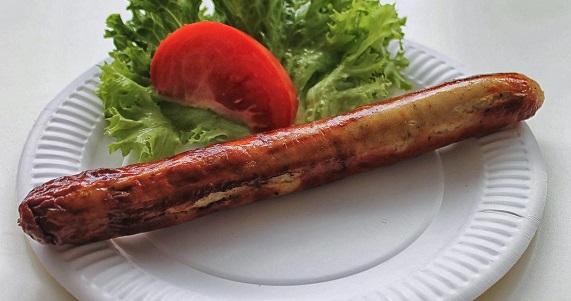
Few dishes represent German comfort food quite like Bratwurst. This iconic sausage, with its juicy interior and perfectly browned casing, is a favorite at beer gardens, barbecues, Oktoberfest celebrations, and home kitchens alike.
While dozens of regional varieties exist – from Franconian to Thüringer styles – the core idea remains simple: a flavorful, coarsely ground pork sausage that’s grilled, pan-fried, or simmered to perfection. In this recipe guide, you’ll learn how to make traditional German bratwurst at home, using accessible ingredients and step-by-step instructions.
History and Regional Background of Bratwurst
The name “Bratwurst” comes from the Old High German words brät (finely chopped meat) and wurst (sausage). Although the term is now associated with grilling (braten), bratwurst has been made since at least the 14th century.
While nearly every German region has its own version, some of the most famous types include:
- Nürnberger Bratwurst – small, thin sausages from Franconia
- Thüringer Rostbratwurst – spicier, longer sausages from Thuringia
- Fränkische Bratwurst – larger and mild in seasoning
Bratwurst is typically made from pork, though beef and veal are occasionally included depending on the style. It’s commonly served with mustard, sauerkraut, or on a bun as a street food snack.
(Explore more about German wurst and their cultural roots.)
Ingredients for Homemade Bratwurst
This recipe yields approximately 12 sausages (about 100g each).
Ingredients:
- 1 kg pork shoulder, well-marbled
- 150 g pork fatback (or additional pork belly)
- 1 tsp kosher salt
- 1/2 tsp ground white pepper
- 1/2 tsp freshly ground black pepper
- 1/4 tsp ground mace or nutmeg
- 1/4 tsp marjoram
- 1/2 tsp garlic powder or finely minced fresh garlic
- 1/2 cup crushed ice or cold water
- Optional: 1 tbsp dry milk powder (for better binding)
- 2–3 meters natural pork casings, soaked and rinsed
Substitutions:
- Fatback can be replaced with pork belly or trimmed fat from shoulder.
- You can omit casings and make Bratwurst patties instead.
Tools and Equipment
- Meat grinder (fine and coarse plates)
- Sausage stuffer or piping attachment
- Mixing bowl
- Sharp knife
- Digital scale (for portioning)
- Skillet, grill, or steamer
Step-by-Step Instructions
Step 1: Prepare the Meat
Cut pork shoulder and fat into chunks. Chill thoroughly in the freezer for 30 minutes to firm up before grinding.
Step 2: Grind the Meat
Using a coarse plate, grind the pork and fat together into a chilled bowl. For a smoother texture, grind a second time using a finer plate.
Step 3: Mix and Season
Add salt, pepper, garlic, nutmeg, marjoram, and crushed ice to the meat. Mix thoroughly by hand or in a stand mixer with a paddle until the mixture becomes sticky and well-combined. This ensures proper binding during cooking.
Optional: Add dry milk powder for extra emulsification.
Step 4: Stuff the Sausages
Rinse casings and load onto a sausage stuffer nozzle. Carefully stuff the meat mixture, taking care not to overfill or trap air bubbles.
Twist into links about 15 cm (6 inches) long. Use a pin or sterilized needle to gently prick any air pockets.
Step 5: Chill or Rest
Lay sausages on a tray and refrigerate, uncovered, for 12- 24 hours. This helps dry the casings slightly and improves flavor.
You can also freeze uncooked bratwurst in sealed bags for up to 3 months.
Cooking Methods
Bratwurst can be cooked several ways. Here are the most common:
1. Grilled Bratwurst (Traditional)
- Preheat grill to medium heat.
- Grill sausages for 15- 20 minutes, turning often until golden and cooked through.
2. Pan-Fried Bratwurst
- Brown sausages in a skillet with a little oil.
- Add a splash of beer or water and cover.
- Simmer for 10- 12 minutes, then uncover to finish browning.
3. Beer-Simmered Bratwurst
- Place sausages in a pot with sliced onions and beer.
- Simmer gently (not boil) for 20 minutes.
- Finish on the grill or in a hot pan to develop color.
The internal temperature should reach 70°C (160°F) for safe consumption.
How to Serve German Bratwurst
Bratwurst can be enjoyed in many ways:
Traditional Serving Suggestions:
- With sauerkraut and mustard
- On a Brötchen (German roll) with onions and mustard
- With potato salad or mashed potatoes
- Over red cabbage or fried onions
Condiments:
- Sweet Bavarian mustard (Süßer Senf)
- Spicy German mustard (Scharfer Senf)
- Onion relish, beer sauce, or curry ketchup (if making Currywurst)
Pair with a crisp German Pilsner, Helles, or non-alcoholic Apfelschorle for an authentic touch.
For side dish ideas, explore our German Salad Recipes.
Variations and Regional Styles
- Nürnberger Bratwurst: Tiny and mildly spiced; often grilled and served in sets of 6–8 with sauerkraut.
- Thüringer Rostbratwurst: Longer, coarser, and spicier; typically grilled over open flames.
- Veal Bratwurst: Popular in southern Germany; contains veal and milk.
- Smoked Bratwurst: Cold-smoked version often found in Alpine regions.
Each region brings its own twist to ingredients, spice blends, and sausage size.
Storage and Safety Tips
- Uncooked bratwurst can be stored in the fridge for 2- 3 days, tightly wrapped.
- Cooked bratwurst keeps for up to 5 days refrigerated.
- Freeze uncooked links for up to 3 months.
- Always thaw in the refrigerator, never at room temperature.
Making German Bratwurst at home brings the flavors of Bavaria, Thuringia, and Franconia into your kitchen. With quality ingredients, a bit of patience, and a good sausage stuffer, you’ll enjoy a classic sausage that’s perfect for grilling season, Oktoberfest parties, or cozy winter dinners.
Ready to explore more wurst recipes? Try Weisswurst – Bavarian White Sausage or dive into the spicy street food favorite: Currywurst – Berlin’s Iconic Sausage.
Related Articles:
12 Types of German Wurst You Should Know
From Bratwurst to Blutwurst, this guide introduces 12 of Germany’s most iconic sausages. Learn what makes each one unique – and how to cook or serve them.
Bratwurst with Sauerkraut and Potatoes – A German Classic
A timeless German comfort food dish featuring juicy Bratwurst, tangy sauerkraut, and tender potatoes. Learn how to cook and serve it the traditional way.
Bratwurst Sauerkraut Casserole with Pretzels
A hearty German bake combining juicy Bratwurst, tangy sauerkraut, and soft pretzel chunks. Perfect for Oktoberfest or cozy cold-weather meals.
Beer Bratwurst Braised with Onions and Apples
Learn how to make Beer Bratwurst Braised with Onions and Apples with this traditional German recipe. Rich in flavor and culture, perfect for any occasion!
What Is Landjäger? Germany’s Hiking Sausage Explained
Find out why Landjäger is Germany’s go-to snack for hikers. Learn how it’s made, how to store it, and what makes it perfect for outdoor adventures.
What Is Mettwurst? Raw-Cured German Sausage Guide
Dive into the world of Mettwurst – a cured, often smoked raw sausage. Discover its regional styles, how to enjoy it safely, and what makes it different from Mett.
What Is Knackwurst? Germany’s Snappy Sausage Explained
Learn all about Knackwurst – the garlicky, juicy sausage that snaps when you bite. See how it’s made and served across Germany.
What Is Bockwurst? Mild German Sausage Explained
Bockwurst is Germany’s mild, family-friendly sausage. Find out why it’s beloved by all ages and how to poach and serve it the right way.
What Is Blutwurst? Traditional German Blood Sausage
Blutwurst is Germany’s traditional blood sausage – rich, hearty, and historic. Learn how it’s made, regional styles, and how to cook or enjoy it cold.
Nürnberger Rostbratwurst – Recipe and History
Explore the legacy of Nürnberger Rostbratwurst – the small sausage with big flavor. Includes authentic preparation methods and cultural background.
What Is Leberwurst? Types and Traditional Recipes
Leberwurst, Germany’s beloved liver sausage, comes in many forms. Discover regional variations, how it’s made, and delicious serving suggestions.
The Best Homemade Currywurst Recipe
Make authentic Berlin-style Currywurst at home with this easy recipe. Includes sausage prep, homemade curry ketchup, and street food-style serving tips.
Weisswurst – Bavarian White Sausage Recipe
Learn how to make and serve Weisswurst – Bavaria’s traditional white sausage. Includes cooking methods, serving customs, and breakfast pairings.







